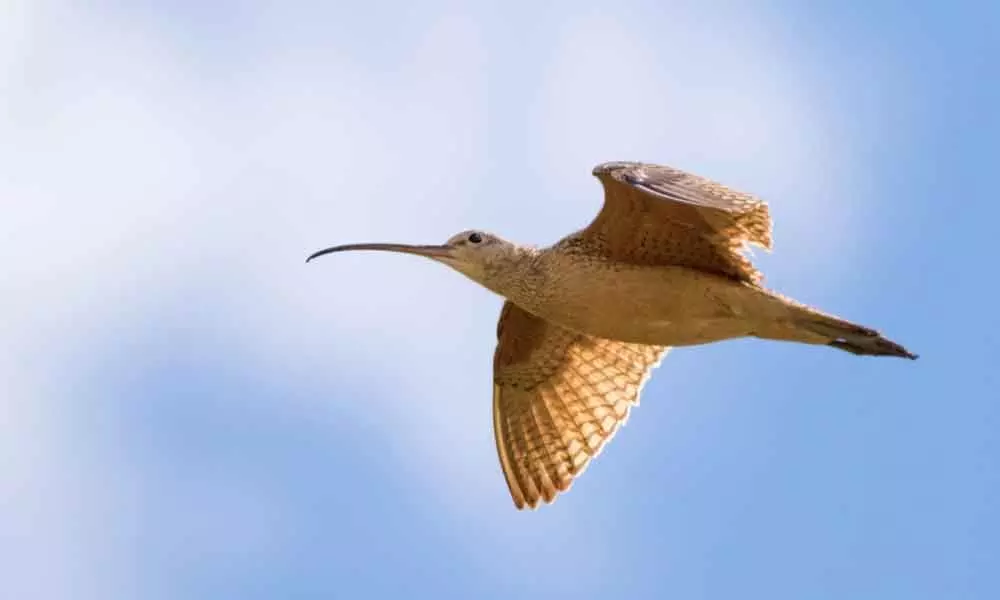Live
- IPL 2024: Devon Conway ruled out due to injury, CSK name Richard Gleeson as replacement
- KK Raju Conducts Enthusiastic Election Campaign in Visakhapatnam Constituency"
- Indian electronics industry sees impressive 154 pc growth in hiring, skilling: Report
- People of Nandigama Seek Freedom from YSRCP: TDP MP Candidate Kesineni Shivanath
- Andhra Pradesh to see direct fight between YSRCP & NDA in Assembly, LS polls
- Yarlagadda Venkatarao Asserts TDP's Commitment to Welfare of Yadavs
- Telugu Desam Party Welcomes several Families into party
- Former Uppal MLA Subhash Reddy resigns from BRS
- Future of the State in Question under YCP Rule: Kavali NDA Alliance Candidate
- Massive Bike Rally in Kaikalur Constituency for unity of yadavs
Just In
Bird migration happening faster in spring due to climate change: Study


Due to global warming, birds migrating during spring are likely to pass certain stops earlier now than they would have 20 years ago, says a first-of-its-kind study examining the impact of climate change on the timing of avian migration.
Due to global warming, birds migrating during spring are likely to pass certain stops earlier now than they would have 20 years ago, says a first-of-its-kind study examining the impact of climate change on the timing of avian migration.
The researchers, including those from the University of Massachusetts Amherst in the US, said atmospheric temperature and migration timing were closely aligned, with the greatest changes to the latter occurring in regions warming most rapidly. They analysed 24 years of radar data from the US National Oceanic and Atmospheric Administration (NOAA) to study nocturnal bird migration.
The findings of the study, published in the journal Nature Climate Change, revealed that timing shifts were less apparent in fall, than during spring. According to the researchers, the nighttime migratory behaviours of hundreds of species - representing billions of birds - is "critically important" to understand the shifting migration patterns. "To see changes in timing at continental scales is truly impressive, especially considering the diversity of behaviours and strategies used by the many species the radars capture," said study co-author Kyle Horton from Colorado State University (CSU) in the US.
Horton added that the observed shifts do not necessarily mean that migrants are keeping pace with climate change. The study's senior author Andrew Farnsworth from Cornell University said bird migration evolved largely as a response to changing climate. "It's a global phenomenon involving billions of birds annually. And it's not a surprise that birds' movements track changing climates. But how assemblages of bird populations respond in an era of such rapid and extreme changes in climate has been a black box," he said.
According to Farnsworth, capturing scales and magnitudes of migration in space and time had been impossible until recently. The researchers said the team's ability to arrive at its findings was possible thanks to its access to radar data, and its use of cloud computing. "To process all of these data, without cloud computing, it would have taken over a year of continuous computing. Instead, the team crunched the numbers in about 48 hours," Horton noted. The bird flight records used in the study were acquired over decades of constantly scanning weather radars by the US National Weather Services' network.
The data had been mostly out of reach for bird researchers, because of the sheer magnitude of information, and the lack of tools to analyse it. The researchers finally overcame this barrier with a new machine learning (ML) tool called "MistNet" which they developed to extract bird data from the radar record. MistNet, whose name refers to the fine, almost invisible, "mist nets" that ornithologists use to capture migratory songbirds, also allows researchers to estimate flying velocity and traffic rates of migrating birds. According to the study, MistNet uses computer vision techniques to differentiate birds from rain on the radar images - a major hurdle that had challenged biologists for decades. "Historically, a person had to look at each radar image to determine whether it contained rain or birds.
We developed 'MistNet,' an artificial intelligence system to detect patterns in radar images and remove rain automatically," explained study co-author Dan Sheldon from the University of Massachusetts Amherst, who developed the tool. The researchers said they were surprised by the lack of change in fall migration patterns, though it tended to be a "little bit messier" during these months. "In the spring, we see bursts of migrants, moving at a fairly rapid pace, ultimately to reach the breeding grounds," Horton explained. "However, during the fall, there's not as much pressure to reach the wintering grounds, and migration tends to move at a slower, more punctuated pace," he said.
Adding to this, the researchers said, birds are not competing for mates in the fall, and the pace to reach their destination is more relaxed. They said there's also a wider age range of birds migrating at this time since the young also eventually realise that they need to migrate. According to Horton, the findings have implications for understanding future patterns of bird migration, since the birds rely on food and other resources as they travel. The researchers believe that under climate change, the timing of blooming vegetation, or emergence of insects may be out of sync with the passage of migratory birds. They cautioned that even subtle shifts could have negative consequences for the health of migratory birds.

© 2024 Hyderabad Media House Limited/The Hans India. All rights reserved. Powered by hocalwire.com






